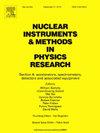Studies of simultaneous operation both round beam and flat beam in a diffraction-limited storage ring
IF 1.5
3区 物理与天体物理
Q3 INSTRUMENTS & INSTRUMENTATION
Nuclear Instruments & Methods in Physics Research Section A-accelerators Spectrometers Detectors and Associated Equipment
Pub Date : 2025-02-11
DOI:10.1016/j.nima.2025.170280
引用次数: 0
Abstract
The diffraction-limited storage rings (DLSRs) can provide an electron beam emittance below 100 , approaching the hard X-rays diffraction limit with better transverse coherence and higher brightness compared to the current light sources, to the synchrotron light users. A round beam with equal horizontal and vertical emittances can effectively mitigate intra-beam scattering effects and increase the Touschek lifetime, however a horizontally elongated flat beam is preferable for some beamline applications with brighter photon beam. Depending on the specific requirement on the experiment, some users prefer high brightness with flat beam while others prefer high horizontal coherence with round beam. To address the limitation of being able to provide only one type of operation mode as either round beam or flat beam, this paper proposes two approaches for the simultaneous operation of both modes with several bunches in flat beam and the other in round beam, namely the flat beam generation in round-beam mode and the round beam generation in flat-beam mode. As an example to demonstrate its feasibility, the lattice design, dynamic aperture, and numerical simulations of these two approaches on the latest lattice of the High Energy Photon Source (HEPS) storage ring, are presented.
求助全文
约1分钟内获得全文
求助全文
来源期刊
CiteScore
3.20
自引率
21.40%
发文量
787
审稿时长
1 months
期刊介绍:
Section A of Nuclear Instruments and Methods in Physics Research publishes papers on design, manufacturing and performance of scientific instruments with an emphasis on large scale facilities. This includes the development of particle accelerators, ion sources, beam transport systems and target arrangements as well as the use of secondary phenomena such as synchrotron radiation and free electron lasers. It also includes all types of instrumentation for the detection and spectrometry of radiations from high energy processes and nuclear decays, as well as instrumentation for experiments at nuclear reactors. Specialized electronics for nuclear and other types of spectrometry as well as computerization of measurements and control systems in this area also find their place in the A section.
Theoretical as well as experimental papers are accepted.

 求助内容:
求助内容: 应助结果提醒方式:
应助结果提醒方式:


